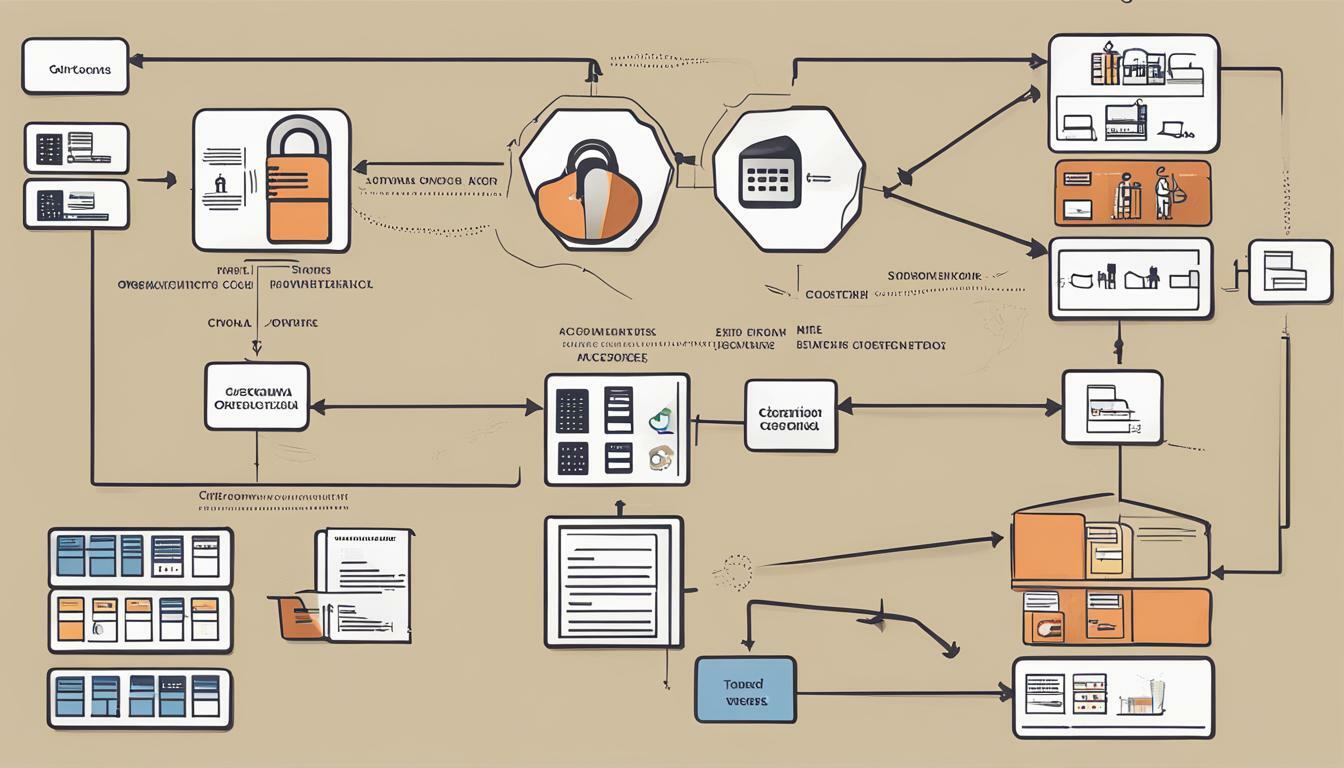
When it comes to protecting sensitive data and ensuring that only authorized personnel have access to it, access control systems are essential. Access control methods, such as Role-Based Access Control (RBAC) and Attribute-Based Access Control (ABAC), allow organizations to manage data protection and meet compliance requirements. However, choosing the right authorization framework that aligns with an organization’s specific needs can be challenging.
In this article, we will explore the differences between RBAC and ABAC and highlight the benefits and limitations of each approach. We will also discuss how customizing authorization can meet an organization’s unique authorization needs.
Key Takeaways:
- Access control systems are crucial for data protection and compliance requirements
- RBAC and ABAC are two access control methods that can be customized to meet specific authorization needs
- Choosing the right authorization framework requires careful evaluation of an organization’s priorities and goals
Understanding Role-Based Access Control (RBAC)
When it comes to access control methods, Role-Based Access Control (RBAC) is a popular choice for many organizations. RBAC is an access control model that assigns permissions to users based on predefined roles. These roles can be defined based on job function, department, or any other categorization that makes sense for the organization.
RBAC has become a popular approach to access control systems because it makes it easier to manage access rights. Instead of defining permissions for each user, permissions are assigned to a role, which is then assigned to users. This simplifies the process of adding or removing access to users as they move through different roles in the organization.
RBAC is also an effective way of enforcing the principle of least privilege, where users are only able to access the resources necessary to perform their job function. This helps to minimize the risk of data breaches and unauthorized access.
Benefits and Limitations of RBAC
One of the benefits of RBAC is its simplicity. It is easy to set up and manage, making it a popular choice for small and medium-sized businesses. RBAC is also scalable, meaning it can be used in larger organizations with many different roles.
However, RBAC does have some limitations. For example, it can be difficult to assign permissions to users who do not fit neatly into predefined roles. Additionally, RBAC is not ideal for situations where there is a lot of variation in user needs. It can also become less effective as the number of roles and users within an organization grows.
Overall, RBAC is a good option for organizations with straightforward access control needs. It provides a simple way of managing access rights and enforcing the principle of least privilege. However, organizations with more complex needs may need to consider other access control models such as Attribute-Based Access Control (ABAC), which we will explore in the next section.
Exploring Attribute-Based Access Control (ABAC)
Access control methods are a critical aspect of any authorization framework. Attribute-Based Access Control (ABAC) is one such method that considers attributes associated with users, resources, and context to determine access rights. ABAC enables organizations to provide access control to resources based on a combination of attributes, providing a more flexible and granular approach to authorization.
ABAC works by evaluating policies based on attributes associated with the user, resource, and environmental context. This evaluation is performed by the Access Control Engine (ACE) which makes access control decisions based on the policy. The policies themselves are defined using a set of Boolean expressions that define the attributes required to access a particular resource or perform a specific action.
ABAC offers several benefits over other access control models, such as Role-Based Access Control (RBAC). Organizations can tailor authorization to specific needs by defining more complex policies based on a combination of attributes. For example, an organization may define policies that allow access only if a user is accessing a resource from a specific IP address during a particular time of day.
While ABAC offers greater flexibility, it can be more challenging to implement than RBAC. Careful consideration is required when defining policies to ensure they are not too restrictive or too permissive. Additionally, as ABAC policies become more granular, they can become harder to manage and maintain.
Despite the challenges, ABAC is becoming an increasingly popular access control method in modern authorization frameworks. It provides a more customized and nuanced approach to authorization that can better align with an organization’s unique needs and priorities.
Comparing RBAC and ABAC: Which is the Right Fit?
As we have seen, Role-Based Access Control (RBAC) and Attribute-Based Access Control (ABAC) are two popular methods for managing access to organizational resources. Both approaches offer unique advantages and limitations that need to be considered before implementing them in an authorization framework.
Access control methods are models that regulate which users are authorized to access resources and what actions they can perform on those resources. RBAC is a popular access control model that assigns permissions based on predefined roles. By having roles defined, RBAC simplifies access management and the audit process. However, the rigid role structure may not always provide the level of granularity required by certain organizations.
ABAC is a more flexible access control model that grants access based on the attributes associated with users, resources, and context. This method offers greater customization in determining access rights and allows for more in-depth contextual analysis. Nevertheless, ABAC can be more challenging to implement and maintain, especially in large-scale organizations.
| Access Control Model | Advantages | Limitations |
|---|---|---|
| RBAC | – Simplifies access management and auditing – Offers clear role-based permissions – Easy to implement and maintain | – Limited granularity – May not be sufficient for highly customized requirements |
| ABAC | – Offers greater customization and flexibility – Allows for in-depth contextual analysis | – Challenging to implement and maintain – Complex rule creation and management |
In terms of authorization frameworks, RBAC is better suited for organizations that require a clear and straightforward approach to access management. On the other hand, ABAC is more appropriate for organizations with complex authorization needs that require greater flexibility and granularity.
It’s also possible to combine RBAC and ABAC to achieve a tailored authorization framework. This hybrid approach can provide the best of both worlds, with the rigid role structures and clear permission assignments offered by RBAC and the contextual analysis and flexible decision-making of ABAC. However, the integration of both methods requires careful planning and consideration to avoid potential conflicts.
Ultimately, the decision between RBAC and ABAC should be based on an organization’s specific authorization needs. By carefully evaluating these requirements, organizations can choose the right access control model that aligns with their goals and priorities.
Conclusion
In conclusion, it is crucial to tailor access control systems to meet specific authorization needs. Role-Based Access Control (RBAC) and Attribute-Based Access Control (ABAC) are two approaches that can help achieve this customization. While RBAC assigns permissions based on predefined roles, ABAC considers user attributes, resource attributes, and context to determine access rights.
Both methods offer benefits and limitations in tailoring authorization. RBAC is simpler to implement and manage, making it well-suited for small organizations with limited resources. However, it may not offer the required granularity for complex authorization requirements. On the other hand, ABAC allows for more flexibility and granular control but may be challenging to implement and manage.
Choosing the Right Access Control System
When deciding between RBAC and ABAC, it is important to evaluate the organization’s authorization needs and priorities carefully. Consider factors such as the size of the organization, the complexity of the authorization requirements, and the resources available for implementation and management.
It is also worth noting that organizations may opt for a hybrid approach, integrating RBAC and ABAC to achieve a tailored and effective authorization framework.
In conclusion, a well-implemented access control system that aligns with an organization’s goals and priorities is crucial for effective authorization management. Choose the right approach, and tailor the system accordingly to ensure optimal security and compliance.
FAQ
Q: What is the difference between Role-Based Access Control (RBAC) and Attribute-Based Access Control (ABAC)?
A: RBAC assigns permissions based on predefined roles, while ABAC considers attributes associated with users, resources, and context to determine access rights.
Q: Which access control method is more customizable?
A: Both RBAC and ABAC can be customized to meet specific authorization requirements, but ABAC offers more flexibility and granularity.
Q: What are the benefits of RBAC?
A: RBAC makes it easier to manage access rights within an organization and simplifies the authorization process.
Q: What are the benefits of ABAC?
A: ABAC offers greater flexibility in tailoring authorization and can handle more complex authorization scenarios.
Q: Are there any limitations to RBAC?
A: RBAC may lack the fine-grained control required for certain authorization scenarios and can become challenging to manage in large organizations.
Q: What challenges might arise when implementing ABAC?
A: Implementing ABAC requires defining and managing attributes for users, resources, and context, and it may require integration with existing systems.
Q: Can RBAC and ABAC be integrated?
A: Yes, RBAC and ABAC can be integrated to achieve a tailored and effective authorization framework that combines the benefits of both approaches.
Q: How should I choose between RBAC and ABAC?
A: When choosing between RBAC and ABAC, it is important to carefully evaluate your authorization needs and consider the advantages and limitations of each method.







